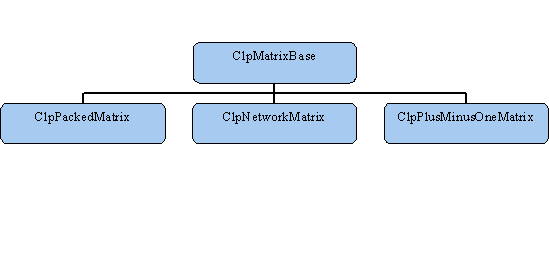The next abstract class of interest is ClpMatrixBase. CLP encapsulates its knowledge of how a matrix is stored in this class. The default instance of this is the ClpPackedMatrix class. This is identical in format to CoinPackedMatrix. Below is a diagram summarizing the hierarchy of the most important matrix classes:

The important new methods implemented are for filling a basis, checking validity of elements and faster "times" and "transposeTimes" when the input array is sparse and/or we have a row copy of the matrix. Advanced users should note that not all methods have to be implemented. In particular, scaling need not be implemented and reverseOrderedCopy can return NULL if a row copy does not make sense.
In addition to the default class, there are two others at present: ClpPlusMinusOneMatrix and ClpNetworkMatrix. As the name implies, the first one is useful when all elements are ±1. In this case multiplies are not needed and more importantly less memory is used and there are fewer cache misses. A class for a matrix where all elements are +1 would be trivial to create. If there were fewer than 64000 rows one could even store row indices as shorts etc.
The use of ClpPlusMinusOneMatrix involves some work as one cannot simply read-in an MPS file. The key is to use loadProblem to pass in a matrix. So if matrix was a CoinPackedMatrix one could do the following:
ClpPlusMinusOneMatrix plusMinus(matrix);
assert (plusMinus.getIndices()); // would be zero if not +- one
model.loadProblem(plusMinus,
lowerColumn,upperColumn,objective,
lower,upper);
ClpNetworkMatrix is similar, but represents a network, thus may only have one element per column. Fortunately, using is is very easy. Given head and tail, one could do the following:
ClpNetworkMatrix network(numberColumns,head,tail);
model.loadProblem(network,
lowerColumn,upperColumn,objective,
lower,upper);
Actual code is in COIN/Clp/Test/unitTest.cpp. A quick glance at the output of this program shows that use of ClpNetworkMatrix gives much faster run times. This is not because of storage issues, but because CLP recognizes the network and uses a network basis factorization which is much faster. However, in this mode CLP is not a genuine network code as it does not take full advantage of the structure by combining operations but it does have the advantage of flexibility.
Other instances are possible. In particular, it should be possible to use the abstract class for column generation or for dynamic matrices which change over time. Minor modifications may be needed but it should work quite smoothly (there is already a dummy "refresh" method which would be used).